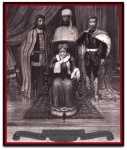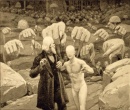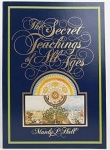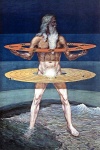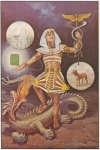J. Augustus Knapp
J. Augustus Knapp was an American Theosophist and artist best known for his suburb illustrations of Manly P. Hall's masterwork The Secret Teachings of All Ages and many works of science fiction and fantasy.
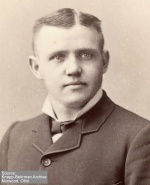
Personal life
John Augustus Knapp was born in Newport, Kentucky on December 1, 1853 as the son of German immigrants. He studied at the McMicken School of Design in Cincinnati, Ohio. He married Emily A. Spring (1858-1910) and they had a daughter Ethel (1880–1943). In 1918, Knapp moved to Los Angeles, although he also spent time living with his daughter Ethel and her family in Norwood, a neighborhood of Cincinnati. His wife Emily had died in 1910, and by 1930 he remarried to a woman named Laura, and was permanently settled in California.
He died in Los Angeles on March 10, 1938.
Theosophical society involvement
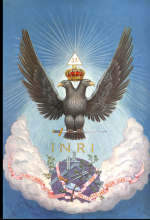
Knapp was admitted as a member of the Cincinnati Theosophical Society on January 19, 1892, giving his address as "Strobridge Lith. Co., Cincinnati, O."[1] Both he and his wife attended lodge meetings at the home of Dr. J. D. Buck, and the also weekly Secret Doctrine class studying The Secret Doctrine using William Quan Judge’s new book The Ocean of Theosophy as a guide.
In 1895, when most branches (lodges) of the American Section voted to separate from the parent society in Adyar, the Cincinnati group also voted to follow William Quan Judge into establishment of a new national organization. Knapp continued to be active with that group rather than affiliating with the Theosophical Society in Adyar, India. On March 2, 1897, for example, he delivered a presentation on the "The Law of Duality in Manifested Nature."
Freemasonry
In addition to his activities in the Theosophical Society, Knapp was an honorary 33° Scottish Rite Freemason. Dr. Buck and James Ralston Skinner were also Masons in Cincinnati.
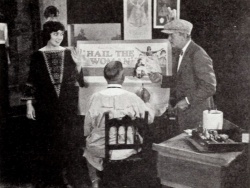
Artistic career
Much of Knapp's career was spent in illustrating a wide variety of books and magazines – occult works, science fiction, poetry, and scientific drawings. One of his paintings that has been of special interest to Theosophists for decades is of Theosophical Society Founder Helena Petrovna Blavatsky seated, with three "Ascended Masters" around her. He also painted posters for Thomas Ince Studios in the early days of Hollywood filmmaking.
Cincinnati years
Early in his career, he held positions in design and lithography at Russell Morgan Lithograph, Strobridge Lithograph, and Cincinnati Process Engraving. At Standard Publishing, he illustrated books and magazines, and it was there that he became acquainted with brothers Curtis Gates Lloyd and John Uri Lloyd.
His first collaboration with John Uri Lloyd was the hugely popular Etidorhpa, or, the End of the Earth: the Strange History of a Mysterious Being and the Account of a Remarkable Journey (1895), which was printed in eighteen editions and in seven languages. It is a fantastic tale of a hollow earth. The title is "Aphrodite" spelled backward. Other works included The Right Side of the Car (1897) and Felix Moses: the Beloved Jew of Stringtown on the Pike (1930).
Curtis Gates Lloyd commissioned the artist to create a portfolio of color illustrations of mushrooms. Plates of Fungi was produced between 1910-20. The originals are displayed at the Lloyd Library and Museum.
Los Angeles years
"In 1918, Knapp moved to Los Angeles, California, where he continued working as a designer, illustrator and painter, at one time employed by Thomas Ince Studios where he participated in the very early days of the movie industry."[2]
While Knapp was no longer active in Theosophical lodge activity, he very likely came into contact with Theosophists at the Krotona Institute in Hollywood; Rosicrucian Max Heindel; astrologer and screenwriter Marc Edmund Jones; James Morgan Pryse; and, of course, Manly Palmer Hall.
Manly Palmer Hall collaborations
Working with Manly Palmer Hall brought him an additional measure of fame. They worked together to design one of the most admired Tarot decks. Knapp illustrated many of Hall's occult books and periodicals, including:
- An Encyclopedic Outline of Masonic, Hermetic, Qabbalistic, and Rosicrucian Symbolical Philosophy: Being an Interpretation of the Secret Teachings Concealed within the Rituals, Allegories, and Mysteries of All Ages. Privately printed by subscription in 1928, this work has been almost continuously in print since then in many editions and under various titles. For this work Knapp created fifty-four full-page color plates that are amazing in their depth of detail.
- The Initiates of the Flame: He Who Lives the Life Shall Know the Doctrine. Los Angeles, 1922. Later editions.
- The Lost Keys of Freemasonry or, the Secret of Hiram Abiff. New York: Macoy, 1923. Many later editions.
- The Tarot: an Essay. Los Angeles: Philosophical Research Society, 1978. Previous and later editions.
Other works
Many of Knapp's illustrations have probably not been credited to him, but his name is associated with these books:
- Collins, Laura Case. Egypt. Cincinnati: The Robert Clarke Company, 1900. A book of poetry.
- Euripedes, translated by James M. Pryse. The Adorers of Dionysos (Bakchai). London: Watkins, 1925.
Knapp also wrote his own book, Divination with Tarot Cards, published by Llewellyn Publications in Los Angeles, 1936.
Gallery of his work
-
HPB with Ascended Masters -
Cover of Etidorpha -
Etidorpha illustration -
Book cover -
Grand Man of the Zohar -
The Hand of the Mysteries -
Hermes on the Back of Typhon -
Grand Rosicrucian Alchemical Formula -
The Jewel of the Rose Croix
Additional resources
Collections and archives
- Lloyd Library and Museum in Cincinnati. Correspondence and plates.
Social Media
- J. Augustus Knapp Facebook page.
- Augustus Knapp Pinterest page.
Notes
- ↑ Theosophical Society General Membership Register, 1875-1942 at http://tsmembers.org/. See book 1, entry 7876 (website file: 1C/49).
- ↑ "John Augustus Knapp" at ARSMagine website. Accessed 1/31/2023. Several Internet sources have the same wording.
